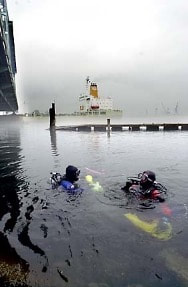Yes, I’m a “River Rat”
December 18, 2022

Pete Perron, one of my old regular dive buds that I regularly dove with in Portsmouth affectionally referred me to as a “river rat” for the number of dives would do in the Piscataqua River. Having logged 280+ dives in the Piscataqua, I guess that qualifies me as one.
Diving in the Piscataqua is not for the faint of heart. The poem from
the Poet Laurette Robert Dunn sums it best. “From here you can see the
tide turn like a door on its hinges. We’re just going out. Do you want
anything from the ocean?” The Piscataqua river is of the fastest
flowing tidal waterways in US (NOAA list of 50 fastest in N. Am). The
ice-free deep-water channel has been used for shipping since the 1600s.
With Tidal current around 4 knots (7.4 km/h; 4.6 mph) the Piscataqua
allows ship to pass during periods of slack tides which is why so many
ships pass by while we're under the water.
I was turned onto diving the Piscataqua River in 2008 through Jay
Gingrich, former owner of the Portsmouth Scuba (and 1st “river rat”). I
was intrigued sites with names like Toilet Hill and the vast collection
of artifacts he had brought up during his years of diving the river. To
date, most of my dives in the river have been off the Pierce Island wall
(no, not Peirce but Pierce), under the Memorial, Sarah Long Bridge and
UNH Pier in Harts Cove and in the back channel off Goat Island.
Pierce Island is such a spectacular site given the unique wall and
underwater topography but also for the variety of life under the water.
I’ve been blessed by huge bait balls of fish, Pogies/Atlantic menhaden
and Pollak, striped bass, Sea raven, short and long horn Sculpin and of
course nudibranchs. In the winter months through early spring, the site
is destination for many macro photographers to capture macro shots of
nudibranchs that feed off the abundant fields of hydroids and anemones
the are lined along the rock walls.The site was featured on an episode
of New Hampshire Chronicle. To view the episode, go to Diving for
Nudibranchs in the Piscataqua
River
Pierce Island happens to be close to where I live, so much more
convenient to get to but it is also a dive site I can dive when the
conditions in the open ocean are blown out to rough seas. During the
winter months, before the snow melt runs off, you can experience
spectacular visibility. The downside of diving the river is the windows
to dive are limited to during slack tide. I find the diving is better at
high tide slack over low though have had good dives during low slack
tide.
The river also offers other interesting site such as the Sarah Long
Bridge, which is a great site to find artifacts, antique bottles. With
each tide cycle, new artifacts are unearthed so there are still cool
things to find. Most of what have found are antique bottles, apothecary
bottles, even stoneware jugs. The river was a means for goods to be
transported on gundalows (shallow drafted wooden cargo barges) up and
down the river to the Great Bay and to the Ocean.
Another favorite site is diving in Harts Cove near Fort Constitution. It’s a great site for finding antique clay pipes and stems, but also a great site for critters directly under the UNH Pier. Like Pierce Island, the site is popular with macro photographers to capture images of Nudibranchs and the anemones that are along the pilings. In the spring and summer months, you’ll find the largest sea stars that feed off the muscles on the bottom. I need to mention that you need to stay clear of the inside harbor, which is a working harbor where the USCG, Marine Patrol and UNH vessels run operations from.
As I said earlier, diving the Piscataqua River isn’t for the faint of heart. The currents are treacherous which is why you should only dive with a professional dive guide or someone familiar with the tide cycles, entry and exits, that has experience diving the sites there.
Just wanted to share my past experiences my 14 years diving as a “river rat”.

